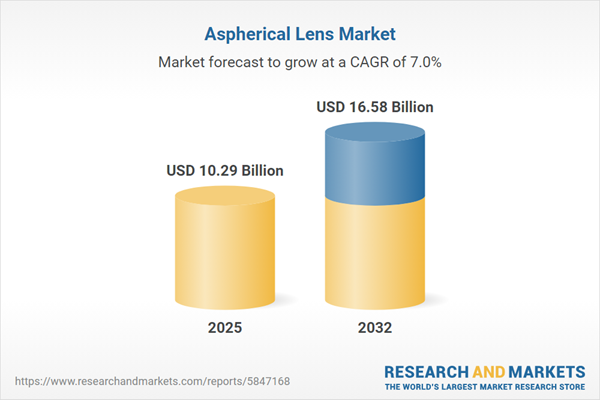Speak directly to the analyst to clarify any post sales queries you may have.
Aspherical lenses are redefining optical performance for enterprises, supporting high-precision requirements across advanced industries while enabling greater efficiency and flexibility through new manufacturing techniques.
Market Snapshot: The Aspherical Lens Market – Momentum Across Industries
The aspherical lens market is recording robust year-over-year revenue growth, supported by a dependable compound annual growth rate. This momentum signals the market’s emergence as a focal segment within advanced optics. Key drivers include rising investments, broadening use cases across high-tech sectors, and steady integration of sophisticated manufacturing technologies. Progress stems chiefly from areas such as automotive electronics, innovative consumer devices, and medical imaging applications. Market leadership is further propelled by companies expanding their product portfolios and adapting operations to meet evolving industry standards and diversified end-user expectations.
Scope & Segmentation of the Aspherical Lens Market
- Material Types: Glass options including borosilicate and crown glass, as well as plastic choices like polycarbonate and PMMA, allow enterprises to tailor performance or durability according to setting and application.
- End Uses: Automotive lighting and sensor modules, smartphones and camera componentry in consumer electronics, industrial tooling for laser equipment and machine vision, as well as medical equipment such as endoscopes and ophthalmic diagnostics.
- Distribution Channels: Direct and distributor-led offline sales, supported by digital sales channels including manufacturer-owned platforms and third-party e-commerce, maximize procurement flexibility for global buyers.
- Applications: Utilizations encompass industrial and scientific laser systems, medical and security imaging, general illumination technologies for smart devices, and specialty optical equipment.
- Price Ranges: Portfolio includes budget-friendly, standard, and premium options, allowing organizations to align optical needs with fiscal strategy or specialized imaging parameters.
- Regions Covered: Major activity spans the Americas, Europe, Middle East and Africa, and Asia-Pacific. Unique industry strengths and procurement priorities shape regional approaches and adaptation strategies.
- Featured Companies: Sector leaders include Canon Inc., Nikon Corporation, Carl Zeiss AG, SCHOTT AG, Hoya Corporation, Corning Incorporated, Sumitomo Electric Industries, Ltd., Ohara Corporation, Edmund Optics, Inc., and Kowa Company, Ltd., each contributing to global reach and continuous innovation.
Key Takeaways for Business Leaders
- Aspherical lenses are increasingly central across automotive, healthcare, and rapid-cycle consumer electronics, as enterprises seek improved optical performance, adaptability, and precision.
- Evolving manufacturing practices such as diamond turning and high-precision molding support minimization of optical errors, higher throughput, and miniaturization for next-generation applications.
- Integration of artificial intelligence and automation into design and quality processes accelerates development and responds to stringent reliability demands in evolving markets.
- Strategic alignment with upstream suppliers and inter-regional partners is crucial for mitigating raw material risks, handling regulatory complexity, and adapting to supply chain changes.
- Flexible pricing models and multi-channel distribution approaches enable suppliers to respond to diverse procurement priorities, whether focused on cost containment or specialized performance outcomes.
Impact of United States Tariffs on Supply Chain and Cost Structures
United States tariffs on critical materials such as borosilicate glass, crown glass, polycarbonate, and PMMA have prompted manufacturers to re-examine sourcing strategies. Enterprises are adopting nearshoring, expanding dual sourcing, and implementing digital oversight tools to strengthen resilience and support continued innovation. These moves enhance supply chain security and position market leaders to adapt to further global changes.
Methodology & Data Sources
This research synthesizes executive interviews, in-depth discussions with frontline engineering teams, comprehensive secondary analysis, and targeted industry validation. All findings are corroborated through real-world feedback and trade documentation, ensuring accuracy and decision-ready insights.
Why This Report Matters
- Gain strategic clarity on aspherical lens market dynamics, including actionable risk factors and opportunities for process innovation.
- Utilize detailed segmentation and regional analysis to inform procurement, optimize investment allocations, and improve competitive positioning.
- Accelerate decision-making with timely, structured insights that reflect both global market realities and emerging local trends.
Conclusion
The aspherical lens market’s progress is shaped by continuing technological innovation and diverse end-user applications. Enterprises that remain proactive are positioned to realize new opportunities and effectively manage future industry developments.
Additional Product Information:
- Purchase of this report includes 1 year online access with quarterly updates.
- This report can be updated on request. Please contact our Customer Experience team using the Ask a Question widget on our website.
Table of Contents
3. Executive Summary
4. Market Overview
7. Cumulative Impact of Artificial Intelligence 2025
List of Figures
Samples

LOADING...
Companies Mentioned
The key companies profiled in this Aspherical Lens market report include:- Canon Inc.
- Nikon Corporation
- Carl Zeiss AG
- SCHOTT AG
- Hoya Corporation
- Corning Incorporated
- Sumitomo Electric Industries, Ltd.
- Ohara Corporation
- Edmund Optics, Inc.
- Kowa Company, Ltd.
Table Information
| Report Attribute | Details |
|---|---|
| No. of Pages | 180 |
| Published | October 2025 |
| Forecast Period | 2025 - 2032 |
| Estimated Market Value ( USD | $ 10.29 Billion |
| Forecasted Market Value ( USD | $ 16.58 Billion |
| Compound Annual Growth Rate | 7.0% |
| Regions Covered | Global |
| No. of Companies Mentioned | 11 |









